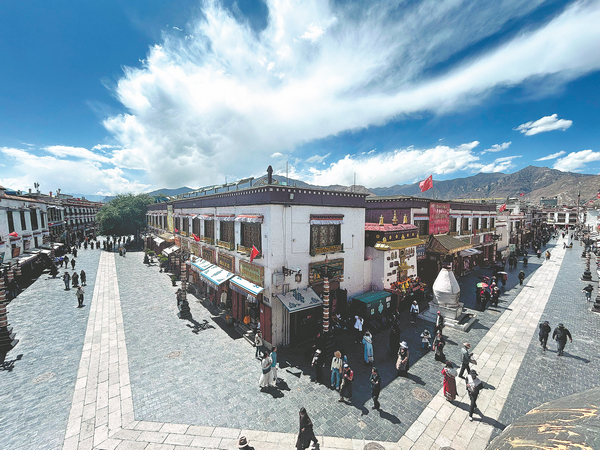
A corner of the 1,300-year-old Barkhor Bazaar in Lhasa, Xizang autonomous region, a bustling center of commerce, and home to multiple cultural, artistic and religious venues, as well as residential compounds. LHAMO/FOR CHINA DAILY
July 15, 2024 -- On Friday local time, US President Joe Biden signed a controversial bill related to Xizang, continuing the United States’ practice of using domestic legislation to interfere in the internal affairs of other countries. This new legislation, however, goes further than previous efforts by introducing the claim that Xizang’s sovereignty is unresolved, denying the historical fact that Xizang has been part of China since ancient times. This move raises serious questions about the US’ commitment to the rules-based international order it claims to uphold. Why has the US, disregarding historical facts and international consensus, decided to flagrantly violate its own longstanding position on Xizang?
First, the US aims to use this unresolved sovereignty narrative as a strategic tool to revitalize its failing strategy of using Xizang to pressure China. Historically, Western powers like the United Kingdom and the US have manipulated issues like Xizang to serve their colonial interests. The so-called Xizang issue emerged from this colonial context. Even today, the West clings to the illusion of separating Xizang from China, using it as a tactic to tarnish, accuse and destabilize China. As China’s peaceful development continues, the traditional US strategy of using Xizang against China is proving increasingly ineffective. Hence, in a desperate move, the US has unveiled this new narrative, directing its administrative bodies to promote it, revealing its ambition to intensify pressure on China and coerce other nations to join its stance.
Second, the US is seeking to extract the last remnants of value from the Dalai Lama and his followers. As the Dalai Lama ages and his clique’s influence wanes due to internal divisions and the increasing fragmentation of the “Tibetan independence activists”, the push for “Tibet independence” is weakening. Both the West and the Dalai Lama’s clique see this as a last-ditch effort. Biden’s timing of signing the bill during the Dalai Lama’s visit to the US for medical treatment underscores this is the final pitch to use the Dalai Lamato serve US interests.
Third, the US is hoping to use this narrative to undermine China’s unity and stability. The malign nature of the unresolved sovereignty claim lies in its intention to deconstruct the historical reality of China. The West avoids acknowledging its own history of coveting, instigating division, and even militarily invading Tibet, instead fabricating various falsehoods about its historical status as part of China. These falsehoods are intended to sow confusion and division. This strategy of inciting regional secession was previously used to destabilize the Soviet Union and is now being attempted against China.
The facts are clear: the West talks about the “Tibet issue”, but they have never genuinely cared about the Tibetan people.
Xizang has been a part of China since ancient times, a fact that is supported by the historical evidence. The US disregards these facts to serve its own agenda. But history cannot be rewritten, and the truth is more powerful than repeated lies. Xizang’s historical status as part of China is undeniable and cannot be negated by any country’s legislation.
The integrated development of the Chinese nation demonstrates that Xizang’s historical status as part of China is irrefutable. China’s historical records clearly delineate its territorial integrity. The close genetic, archaeological and linguistic ties between the Tibetan and Han peoples further affirm this. Historical documents, such as the inscriptions at Jokhang Temple, vividly capture the longstanding unity between Xizang and other provinces in China. These historical facts are unassailable.
The historical relationship between successive central governments and Tibet’s local authorities underscores its unquestionable legal status as part of China. From the Yuan Dynasty (1271-1368) onwards, various central governments have exerted effective administration over Tibet in different ways. Historical documents, in both Tibetan and Chinese records, provide unequivocal evidence of this relationship.
The continuous interactions and integrations among the various ethnic groups within China have formed an inseparable national community. Throughout history, the Tibetan people have stood alongside other Chinese ethnic groups, showcasing unity and resilience against foreign invasions and contributing to the nation’s collective strength. This unity cannot be invalidated by any foreign legislation.
In conclusion, the recent US legislation related with Xizang is not only a blatant interference in China’s internal affairs but also a misguided attempt to rewrite history and destabilize China. But the historical and factual reality of Xizang as an integral part of China stands firm, beyond the reach of any external political maneuvering.
The author is deputy director of and a research fellow at the Institute of Historical Studies at the China Tibetology Research Center.
The views don’t necessarily reflect those of China Daily.


